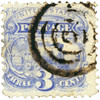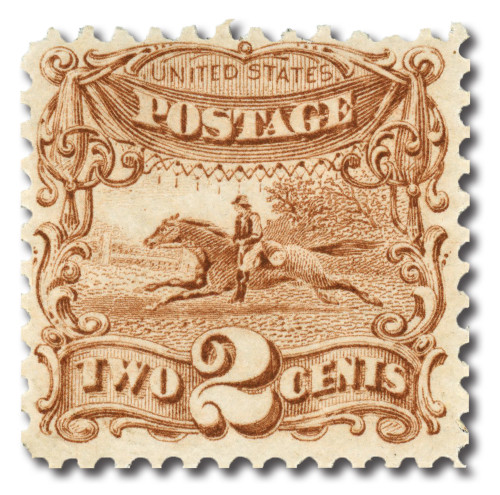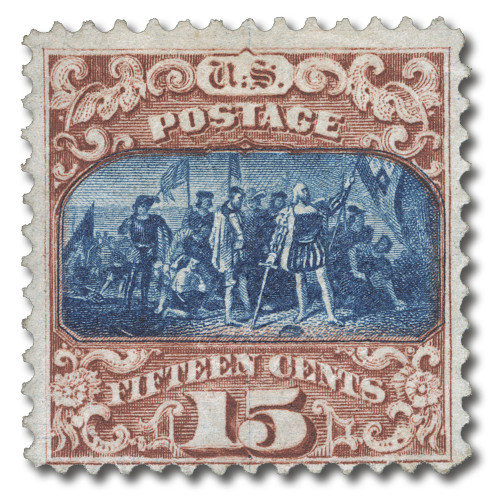
# 114 - 1869 3¢ Locomotive, ultramarine
U.S. #114
1869 Locomotive
- First US postage stamp to picture a train
- Hard to find with good centering
- Ranked #18 in 100 Greatest American Stamps
Stamp Category: Definitive
Series: 1869
Value: 3c
Issue Date: March 19, 1869
Earliest Documented Use: March 27, 1869
Printed by: National Bank Note Co.
Quantity printed: 335,534,850
Format: Printed in sheets of 300 stamps, divided into vertical panes of 150 each
Printing Method: Engraving
Perforations: 12
Color: Ultramarine
Why the stamp was issued: The main usage for the 3c Locomotive Pictorial was payment of the half-ounce first class domestic letter rate. It saw more use than any of the other Pictorial stamps.
About the printing: The design was engraved on a die – a small, flat piece of steel. The design was copied onto a transfer roll – a blank roll of steel. Several impressions or “reliefs” were made on the roll. The reliefs were transferred to the plate – a large, flat piece of steel from which the stamps were printed.
About the design: The artwork is based on a National Bank Note Company design, used previously on its currency bank notes. William Frangipane, in his United States Stamps: A History, makes the argument that the stamp is, in a way, the first US commemorative stamp as it celebrates the completion of the Transcontinental Railroad, as well as the fast mail service of the era.
About the 1869 Pictorial Series:
It was suggested this new series honor the history of the US Post Office. According to the Post Office’s request for contract bids – the new series would begin “with Franklin, the Continental postmaster, and the post rider of the early days, followed by the locomotive of a later day and the ocean steamer carrying the mails… the most important scenes in the early history of the country, its triumphant arms, and Washington its first, and Lincoln its last president.”
As result, the 1869 Pictorials were the first US stamps to feature something besides the bust or head of an American president or statesman. This marked a significant change in US stamp design. For the first time, methods of transportation, symbols of America, historic events, and explorers appeared on postage stamps. The Pictorials are considered by some to be forerunners of US commemorative stamps.
Though sought-after today, the Pictorials were unpopular at the time of their issue. Some Americans thought it unpatriotic to replace the nation’s leaders with other subjects. Though expected to be printed over a period of four years, the stamps were withdrawn from sale within a year of their release.
Printed on hard white wove paper, five of the stamps were the first US issues to be printed in two colors. Using two colors required two press runs, one to print the center design (vignette) and one to print the frame. This led to the accidental creation of some rare inverts of numbers 119, 120 and 121 – the first inverts in US postal history.
The series consists of eleven stamps – US #112-122. Each stamp was embossed with the “G” grill, added to prevent reuse of the stamps. The stamps have a unique, nearly square shape, not used on any other US postage stamp for almost 70 years. Their G grill was nearly square as well, smaller than earlier grills due to the smaller stamp size. The G grill was used exclusively on the Pictorial Series.
History the stamp represents:
The 3c locomotive stamp carried on the theme of a history of the US Post Office. As with other stamps in the series, having an image other than a president or statesman was a preview of things to come: the full-fledged commemorative stamps of the next generation.
When the stamp was issued, the transcontinental railroad was less than two months away from completion. The stamp not only celebrates the speed with which mail delivery was being accomplished by rail at the time, but also that historic event.
More About Grills:
Grills were introduced because the U.S. Post Office Department was worried about the removal of cancellations, allowing for fraudulent reuse of a stamp. Grills were made by embossing the stamp with a pattern to break down paper fibers, allowing cancellation ink to soak deeply into the paper. This made it impossible to remove cancels, as even regular pen ink, used to manually cancel stamps at smaller post offices, would penetrate the fibers.
There were several proposals for different ways to solve the problem. Charles Steel, who oversaw stamp production at the National Bank Note Company in the 1860s, developed and patented the grilling method. He was granted a patent for the process on October 22, 1867. Steel also saw the process as helping stamps adhere better to mail.
According to Steel’s patent, “The object of my invention is to produce a stamp which shall stick better than usual, and which it shall be impossible to fraudulently remove and use again.” Steel’s simple machine used a roller pitted with either small depressions or small raised pyramids to break fibers in the stamp paper. The rollers with depressions created a “points up” pattern while those with raised pyramids made a “points down” pattern.
The United States was the first country to issue grilled stamps and was the only country to do so until the mid-1870s, when Peru also began using grills. The National Bank Note Company was responsible for producing both countries’ stamps.
Grills were used for only nine years – 1867 to 1875, encompassing the 1869 Pictorial Series (#112-22) and the 1870-71 Bank Notes (#134-44). The National Bank Note Company attempted to find the perfect grill size by experimenting with various versions. The large A, B, and C grills weakened the paper too much. As time went on, the rollers were ground down to produce smaller-sized grills that would prevent the stamp from tearing easily, but wouldn’t let the ink penetrate the paper. That resulted in grills too weak to do the job. There was also the issue of extra expense, plus, the reuse of stamps wasn’t as prevalent as postal authorities feared. This historic postal era had come to an end.
In 1916, William L. Stevenson measured all known grill sizes and categorized them. He gave each a letter from A to J. The exception was the “Z” grill, as he was unsure to which grill family it belonged. Nor did he know which family it preceded or followed, so he used the letter “Z” to signify the unknown. It differs from other grill patterns because the tiny ridges on each peak are oriented horizontally instead of vertically.
Grills are classified by the dimensions of the grill pattern and are measured in millimeters or by counting the number of grill points. There are eleven major classifications:
“A” Grill Covers the entire stamp
“B” Grill 18x15mm (22x18pts)
“C” Grill 13x16mm (16 to 17x18 to 21pts)
“D” Grill 12x14mm (15x18 to 19pts)
“Z” Grill 11x14mm (14 to 15x17 or 18pts)
“E” Grill 11x13mm (14x16 to 18pts)
“F” Grill 9x13mm (12x16 to 18pts)
“G” Grill 9½ x9mm (12x11 to 11½ pts)
“H” Grill 10x12mm (11 to 13x14 to 16pts)
“I” Grill 8½ x10mm (10 to 11x10 to 13pts)
“J” Grill 7x9½ mm (9 to 10x12pts)
The letters classifying the various grill types do not denote the size, shape, or appearance of the grills. They indicate the order in which each was discovered.
Mostly visible only from the back of the stamp, grills may be felt by lightly running a fingertip over the surface. Depending on which roller was used, the pattern is “points up” or “points down.” The ridges on an indented roller force the paper into the recesses, creating raised points, while a roller with raised pyramids will cause the points to be forced down into the paper, forming a series of depressions.
Grilling resulted in some of the greatest U.S. stamp rarities, including the legendary 1c “Z” Grill (U.S. #85A) owned by Mystic Stamp Company for several years. In June, 2024, the 1c Z Grill sold for almost $4.4 million dollars at auction, as part of the William H. Gross collection of classic U.S. stamps.
U.S. #114
1869 Locomotive
- First US postage stamp to picture a train
- Hard to find with good centering
- Ranked #18 in 100 Greatest American Stamps
Stamp Category: Definitive
Series: 1869
Value: 3c
Issue Date: March 19, 1869
Earliest Documented Use: March 27, 1869
Printed by: National Bank Note Co.
Quantity printed: 335,534,850
Format: Printed in sheets of 300 stamps, divided into vertical panes of 150 each
Printing Method: Engraving
Perforations: 12
Color: Ultramarine
Why the stamp was issued: The main usage for the 3c Locomotive Pictorial was payment of the half-ounce first class domestic letter rate. It saw more use than any of the other Pictorial stamps.
About the printing: The design was engraved on a die – a small, flat piece of steel. The design was copied onto a transfer roll – a blank roll of steel. Several impressions or “reliefs” were made on the roll. The reliefs were transferred to the plate – a large, flat piece of steel from which the stamps were printed.
About the design: The artwork is based on a National Bank Note Company design, used previously on its currency bank notes. William Frangipane, in his United States Stamps: A History, makes the argument that the stamp is, in a way, the first US commemorative stamp as it celebrates the completion of the Transcontinental Railroad, as well as the fast mail service of the era.
About the 1869 Pictorial Series:
It was suggested this new series honor the history of the US Post Office. According to the Post Office’s request for contract bids – the new series would begin “with Franklin, the Continental postmaster, and the post rider of the early days, followed by the locomotive of a later day and the ocean steamer carrying the mails… the most important scenes in the early history of the country, its triumphant arms, and Washington its first, and Lincoln its last president.”
As result, the 1869 Pictorials were the first US stamps to feature something besides the bust or head of an American president or statesman. This marked a significant change in US stamp design. For the first time, methods of transportation, symbols of America, historic events, and explorers appeared on postage stamps. The Pictorials are considered by some to be forerunners of US commemorative stamps.
Though sought-after today, the Pictorials were unpopular at the time of their issue. Some Americans thought it unpatriotic to replace the nation’s leaders with other subjects. Though expected to be printed over a period of four years, the stamps were withdrawn from sale within a year of their release.
Printed on hard white wove paper, five of the stamps were the first US issues to be printed in two colors. Using two colors required two press runs, one to print the center design (vignette) and one to print the frame. This led to the accidental creation of some rare inverts of numbers 119, 120 and 121 – the first inverts in US postal history.
The series consists of eleven stamps – US #112-122. Each stamp was embossed with the “G” grill, added to prevent reuse of the stamps. The stamps have a unique, nearly square shape, not used on any other US postage stamp for almost 70 years. Their G grill was nearly square as well, smaller than earlier grills due to the smaller stamp size. The G grill was used exclusively on the Pictorial Series.
History the stamp represents:
The 3c locomotive stamp carried on the theme of a history of the US Post Office. As with other stamps in the series, having an image other than a president or statesman was a preview of things to come: the full-fledged commemorative stamps of the next generation.
When the stamp was issued, the transcontinental railroad was less than two months away from completion. The stamp not only celebrates the speed with which mail delivery was being accomplished by rail at the time, but also that historic event.
More About Grills:
Grills were introduced because the U.S. Post Office Department was worried about the removal of cancellations, allowing for fraudulent reuse of a stamp. Grills were made by embossing the stamp with a pattern to break down paper fibers, allowing cancellation ink to soak deeply into the paper. This made it impossible to remove cancels, as even regular pen ink, used to manually cancel stamps at smaller post offices, would penetrate the fibers.
There were several proposals for different ways to solve the problem. Charles Steel, who oversaw stamp production at the National Bank Note Company in the 1860s, developed and patented the grilling method. He was granted a patent for the process on October 22, 1867. Steel also saw the process as helping stamps adhere better to mail.
According to Steel’s patent, “The object of my invention is to produce a stamp which shall stick better than usual, and which it shall be impossible to fraudulently remove and use again.” Steel’s simple machine used a roller pitted with either small depressions or small raised pyramids to break fibers in the stamp paper. The rollers with depressions created a “points up” pattern while those with raised pyramids made a “points down” pattern.
The United States was the first country to issue grilled stamps and was the only country to do so until the mid-1870s, when Peru also began using grills. The National Bank Note Company was responsible for producing both countries’ stamps.
Grills were used for only nine years – 1867 to 1875, encompassing the 1869 Pictorial Series (#112-22) and the 1870-71 Bank Notes (#134-44). The National Bank Note Company attempted to find the perfect grill size by experimenting with various versions. The large A, B, and C grills weakened the paper too much. As time went on, the rollers were ground down to produce smaller-sized grills that would prevent the stamp from tearing easily, but wouldn’t let the ink penetrate the paper. That resulted in grills too weak to do the job. There was also the issue of extra expense, plus, the reuse of stamps wasn’t as prevalent as postal authorities feared. This historic postal era had come to an end.
In 1916, William L. Stevenson measured all known grill sizes and categorized them. He gave each a letter from A to J. The exception was the “Z” grill, as he was unsure to which grill family it belonged. Nor did he know which family it preceded or followed, so he used the letter “Z” to signify the unknown. It differs from other grill patterns because the tiny ridges on each peak are oriented horizontally instead of vertically.
Grills are classified by the dimensions of the grill pattern and are measured in millimeters or by counting the number of grill points. There are eleven major classifications:
“A” Grill Covers the entire stamp
“B” Grill 18x15mm (22x18pts)
“C” Grill 13x16mm (16 to 17x18 to 21pts)
“D” Grill 12x14mm (15x18 to 19pts)
“Z” Grill 11x14mm (14 to 15x17 or 18pts)
“E” Grill 11x13mm (14x16 to 18pts)
“F” Grill 9x13mm (12x16 to 18pts)
“G” Grill 9½ x9mm (12x11 to 11½ pts)
“H” Grill 10x12mm (11 to 13x14 to 16pts)
“I” Grill 8½ x10mm (10 to 11x10 to 13pts)
“J” Grill 7x9½ mm (9 to 10x12pts)
The letters classifying the various grill types do not denote the size, shape, or appearance of the grills. They indicate the order in which each was discovered.
Mostly visible only from the back of the stamp, grills may be felt by lightly running a fingertip over the surface. Depending on which roller was used, the pattern is “points up” or “points down.” The ridges on an indented roller force the paper into the recesses, creating raised points, while a roller with raised pyramids will cause the points to be forced down into the paper, forming a series of depressions.
Grilling resulted in some of the greatest U.S. stamp rarities, including the legendary 1c “Z” Grill (U.S. #85A) owned by Mystic Stamp Company for several years. In June, 2024, the 1c Z Grill sold for almost $4.4 million dollars at auction, as part of the William H. Gross collection of classic U.S. stamps.

























